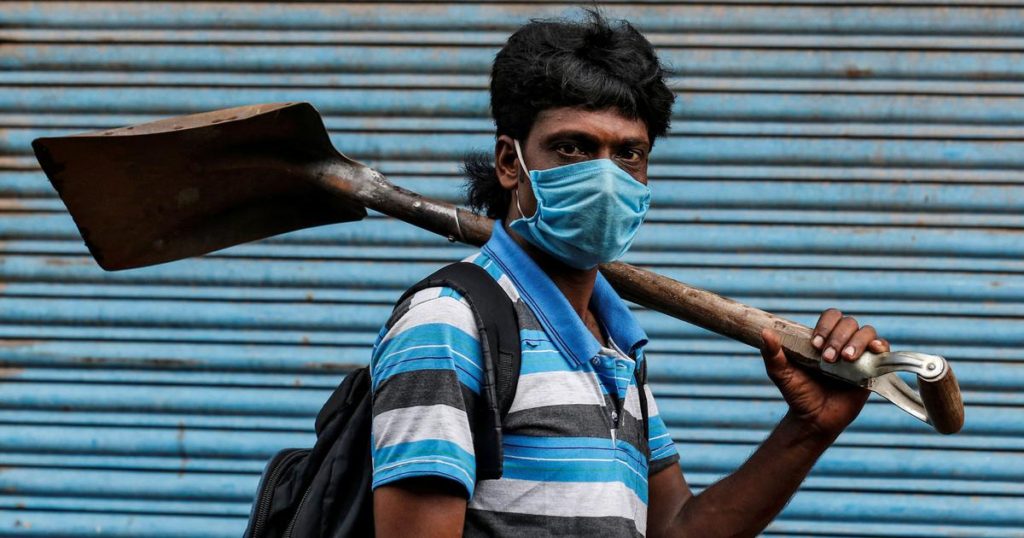The 34% rise in capital expenditure promised in the 2021-’22 Budget – from Rs 4.12 lakh crore in 2020-’21 to Rs 5.54 lakh crore – may not do much to resolve the employment crisis caused by the pandemic-led lockdown, our analysis shows. The push for big, long-gestation infrastructure projects is good but may not result in many jobs, economists say, and the budget merely reiterates the provisions of the labour codes passed in 2019 and 2020 by Parliament on social security and universal minimum wages.
The Budget has reduced the allocation for the Mahatma Gandhi National Rural Employment Guarantee Scheme, the flagship programme for employment generation in India’s villages, and a lifeline for millions of unemployed migrant workers who had to return home during the lockdown. It has also not introduced any urban jobs initiatives along the lines of MGNREGS, as advocated by livelihood agencies in the wake of the pandemic-led economic distress.
The Ministry of Labour and Employment has been allocated Rs 13,306.5 crore, Rs 413 crore less than the revised estimate for 2020-’21. Of this, the allocation for existing social security schemes for workers is down 3.4% to Rs 11,104 crore.
In December 2019, four months before the lockdown, about 48% of India’s workforce was self-employed and by August 2020, this number rose to 64%, indicating declining job opportunities, IndiaSpend reported in January 2021.
The Budget had been expected to focus significantly on employment generation across sectors in rural and urban India, but experts interviewed by IndiaSpend are sceptical about the Budget’s ability to deliver on this.
Why big infra may not bring in many jobs
Throughout her 110-minute speech, the finance minister announced schemes and allocations across textiles, shipping and infrastructure sectors that hold the promise of increased employment. Here are some of these:
- A production-linked initiative for 13 sectors with an outlay of Rs 1.97-lakh crore over five years.
- Seven Mega Investment Textiles Parks to be launched over the next three years. The basic customs duty for textile raw materials will go down to 5%.
- A capital outlay of Rs 1,08,230 crore has been announced for the Ministry of Road Transport and Highways, plus economic corridors and national highway works for Tamil Nadu, Kerala, West Bengal and Assam.
- A public bus transport augmentation scheme for urban areas worth Rs 18,000 crore has been announced, to work on the public-private partnership model.
While these schemes and initiatives will create employment opportunities, they are unlikely to be realised anytime soon, said experts. “The push in infrastructure is good, but it depends on how quickly projects like economic corridors will start,” Radhicka Kapoor, an economist and senior fellow at Indian Council for Research on International Economic Relations told IndiaSpend. “These projects have long gestation periods.”
“Large infrastructure projects are very capital-intensive these days,” said Amit Basole, associate professor at Azim Premji University and researcher at Centre for Sustainable Employment, explaining why they may not create many jobs. “Most construction jobs are created in residential and commercial projects, not in large infrastructure projects.”
“The setting up of textile parks would be positive given that the sector is labour-intensive,” said Bhabesh Hazarika, economist, National Institute of Public Finance and Policy, but added that the allocations announced were inadequate.
The production-linked initiative outlay is big, but will be spread over five years so it may not see large-scale employment generation, also because the support is being offered mostly to capital-intensive industries, said Kapoor.
Experts also pointed to the lack of relief for India’s micro, small and medium enterprises, a sector that employs nearly 40% of the country’s informal workers. This sector was hit the worst by the lockdown with many small units going bankrupt, said Basole.
While the allocation for the MSME ministry in 2021-’22 doubled from the current financial year’s budget estimate of Rs 7,572 crore to Rs 15,700 crore, 64% of the allocation is for the Guarantee Emergency Credit Line facility, a scheme for providing fully guaranteed and collateral-free credit to MSMEs, business enterprises, individual entrepreneurs and Micro Units Development and Refinance Agencies borrowers.
“MSME support was more in terms of liquidity and credit guarantees,” said Kapoor, adding that since most of the sector is informal and unregistered, there will be limited uptake of the loans and credit guarantees.
MGNREGS gets less than 2020-’21 revised estimate
The rural jobs programme, which guarantees 100 days of work a year to adult members of every rural household, has 144 million active workers. Distressed jobless migrants returning home during the lockdown had applied for work through MGNREGS but over 9.7 million households in need of jobs could not find any, IndiaSpend reported.
In June 2020, a record budgetary allocation of Rs 61,500 crore for MGNREGS (2020-’21) had to be supplemented with an additional Rs 40,000 crore to deal with the pandemic-led employment crisis. Despite an increased budgetary allocation of Rs 73,000 crore for 2021-’22, the amount being made available is 35% lower than the 2020-’21 revised estimate – the amount estimated to have been spent (as opposed to the amount budgeted for at the start of the fiscal year) – of Rs 1,11,500 crore.
“This budgetary allocation is inadequate,” said Indian Council for Research on International Economic Relations’s Kapoor. “There is a demand for MGNREGS as labour markets are reeling under a lot of distress, and the Covid crisis is not over yet.”
MGNREGS has always been underfunded, said Reetika Khera, economist and associate professor at the Indian Institute of Technology-Delhi. “Even the enhanced budget last year was only one-third of what would be required to fulfil the promise of 100 days of work to all job card holding families,” she said.
Given the acute and widening economic inequalities in India, the Budget could have been an opportunity to strengthen MGNREGS and stem distress migration to cities, said Rajendran Narayanan, assistant professor at Azim Premji University and founding member of LibTech India, a project for improving transparency and accountability in the delivery of public services in rural areas. “The government’s Budget is largely focussed on supply-side measures and completely ignores demand-side measures, as is evident from its silence on allocation for MGNREGS and other possible livelihood creation programmes,” he said.
Union Budget Funding for Rural Jobs Programme
No urban jobs initiative, a ‘missed opportunity’
Urban job schemes along the lines of the MGNREGS, already in place in some states such as Odisha, Himachal Pradesh, Jharkhand and Kerala, are imperative in the ongoing economic crisis, IndiaSpend had reported. Agriculture continued to employ more people than usual in 2020, indicating that non-agricultural jobs in urban areas are fewer due to the impact of the pandemic, according to a January 2021 Centre for Monitoring Indian Economy analysis.
Employment in agriculture declined to 15.4 crore during October-December 2020, from 15.8 crore in the previous quarter (July-September). But this was still 3.5% higher than the level during October 2019-December 2019, the analysis showed.
The absence of an urban job generation initiative is a “missed opportunity” in the new Budget, said Basole. It was important “not only to offer some compensation to urban workers who have been hit hard, but also to show that the government is committed to improving local infrastructure, not just big infrastructures like airports or highways”, he said.
The Economic Survey did not acknowledge the problem of unemployment during the Covid-19 crisis, said KR Shyam Sundar, professor of human resource management at the Xavier School of Management, in a press statement. “Is it not high time to start an urban employment assurance scheme given that there is no unemployment insurance/assistance scheme (except a narrowly-defined one under the Employees State Insurance Act, 1948 which has few takers)?” he asked.
Security for unorganised workers only ‘advisory’
Efforts to analyse the job distress during the lockdown showed that India does not have data on its informal and unorganised sector. The government admitted in Parliament that it did not have data on the number of migrant workers who had been rendered jobless or died during their long walk home. It set up an expert group to gather migrant data and suggest ways to improve their work conditions and job opportunities.
The Budget has included Rs 150 crore for a national database on unorganised workers. It has proposed a new portal to collect relevant information on gig, building and construction workers, among others, to help formulate health, housing, skill, insurance, credit and food schemes for migrant workers.
But the budget announcement to provide social security to gig and platform workers for the “first time globally” is only a reiteration of the government’s code on social security as no allocation has been announced for the purpose, experts said.
“The code mentions security for unorganised sector workers but it is largely advisory in nature but no budgetary allocation has been made for the unorganised sector apart from setting up a national database,” said Kapoor from Indian Council for Research on International Economic Relations.
The code provides for a social security fund comprising contributions from gig employers and the Centre or state government, with gig companies expected to allot 1%-2% of their annual turnover. However, the code does not clearly define who a platform, gig and casual worker is, making this provision difficult to implement, Kapoor said.
(Courtesy: IndiaSpend, a data-driven and public-interest journalism non-profit.)




